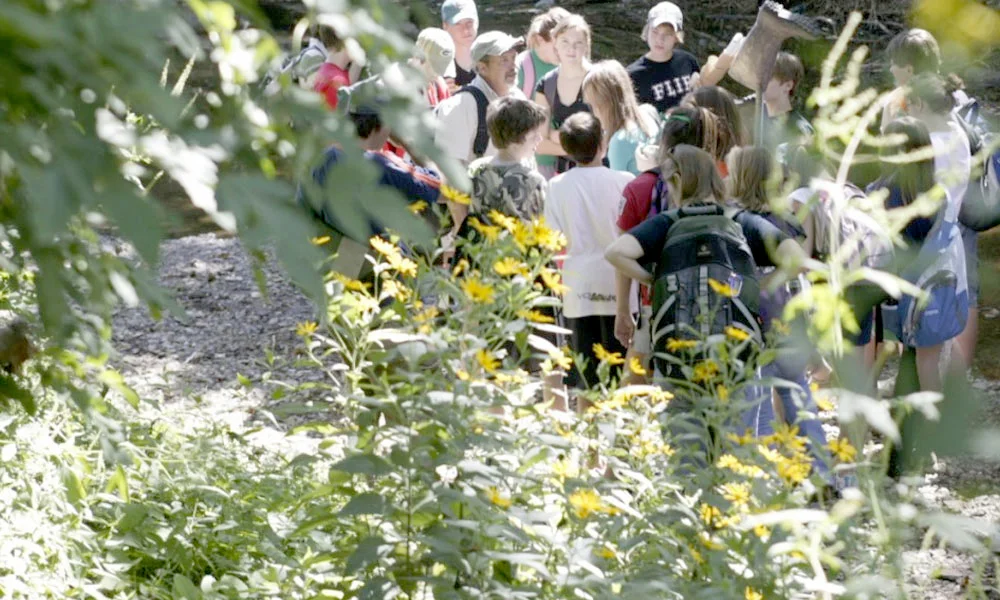Finding air bubbles in ice
January and February have been months of contrasts for us. In January we were lucky enough to visit the island of Culebra in Puerto Rico where it was warm and sunny and we walked beaches every day. At home in Vermont, it has been snowy and cold and we have walked the Trail Around Middlebury often and sometimes hiked up the Middlebury College Snow Bowl with back country skis. In the February newsletter of the Bread Loaf Mountain Zen Community, guiding teacher, Joshin Byrnes began with a poem by 17th century Japanese poet, Basho.
Winter solitude
In a world of one color
The sound of the wind.
I find I am carrying these words with me out into the snowy world.
Children and teachers at Principia School exploring the woods in the snow
As I walk or hike, wherever I am this winter, I also consider a poem of Sister Jina, a nun from the Netherlands, who coordinated the Family Retreat who we met in the 90s with Thich Nhat Hanh in Plum Village.
In a new book, Moments of Joy, she writes small poems for each season. In the Winter section she writes.
Walking in moonlight
Walking in starlight
Only my thoughts can disturb me
She writes in her introduction. I was not looking for anything. Beautiful moments just happened and were spontaneously expressed in words. She continues, I hope you will savor these moments of joy and be inspired to record your own. May many wonders reveal themselves to you on your path.
Aerial image of spiral in the snow by photographer Caleb Kenna used with permission
The poems that Sister Jina writes are not haiku strictly speaking, with rules about syllables, yet they have the feeling of haiku because many are focused on the natural world, do not use personal pronouns or punctuation for the most part, and focus on an arresting image, also for the most part.
I began thinking of our friend John Elder, professor emeritus at Middlebury College, and his practice of inviting students to collaborate on the poetry form called renga. In Japanese culture, the renga form also has strict rules. John uses a looser, more friendly and flexible form. Renga is a stringing together of haiku like images by different authors who are listening to one another and responding with their own images. Renga writing is often practiced outside in different seasons. Renga is a practice of collaborative haiku like poems, often spoken rather than written, of short phrases of images, seasonal references, without personal pronouns.
It occurs to me that young children often compose haiku like phrases and with them we can create a kind of renga. I “caught”this renga out of phrases spoken by our grandchildren, ages three, seven, and nine yesterday on a walk.
Why does ice melt?
Air bubbles in the ice move slowly.
Listen to the sweet sap falling into the bucket.
Why is maple sap sweet?
Hear the backyard birds!
Red-winged blackbirds up in the trees.
Another idea is to combine creating haiku like phrases or renga with the practice of Seton Watching, named for Ernest Thompson Seton (1860-1946), that I learned at the Vermont Institute of Natural Science…Sitting quietly in the natural world, waiting for what happens and what you notice…an animal passing by, a bird song, the wind in the grasses. Find resources on Seton Watching practice with students here and here.
Often, the wonders we notice also inspire play with the elements themselves. Especially for children, who are always playing with leaves, sticks, pebbles, mud, ice, as natural materials in the natural world. Like the spirals on the beach and in the snow pictured in this post. For many of us this play brings to mind the inspiration of Andy Goldsworthy and his interplay with the natural world to make beautiful, ephemeral compositions.
Spiral of coral and stones found on a pebble beach
Both of these practices, simple poems with few words, and playing with the elements of the world invite and nurture presence, play, joy, and wonder. They can be done individually or in a small group. These along with other practices and resources help to inform and shape a curriculum for learning in the natural world.
At Principia, a school in St. Louis where we work with the early childhood team, one class of four and five year olds and their teachers has been spending days outside every week in part of their campus called the East Woods. They are taking their time, exploring, drawing, wondering, imagining, in different seasons and times of day. They are learning through time and experience who lives in this particular woods close to their school.
Children at Principia drawing and writing in the woods
Among other resources, the teachers are inspired by Ann Pelo’s book, The Goodness of Rain. Ann Pelo writes…
This is what I want for children: a sensual, emotional, and conscious connection to place; the sure, sweet knowledge of earth, air, sky. As a teacher, I want to foster in children an ecological identity, one that shapes them as surely as their cultural and social identities. I believe that this ecological identity, born in a particular place, opens children to a broader connection with the earth; love for a specific place makes possible love for other places. An ecological identity allows us to experience the earth as our home ground, and leaves us determined to live in honorable relationship with our planet.
May we all find ways to be present, joyful, and grounded in the natural world on our own, with others, and side by side the children we love and teach.











